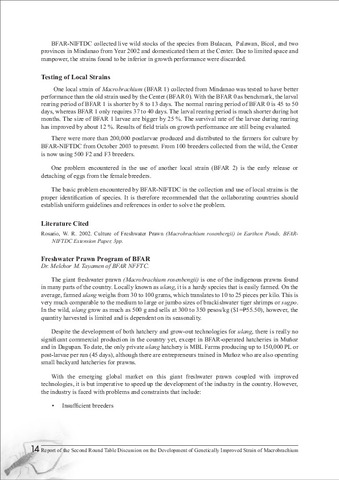Freshwater prawn program of BFAR
- Global styles
- MLA
- Vancouver
- Elsevier - Harvard
- APA
- Help
Share
Abstract
The giant freshwater prawn (Macrobrachium rosenbengii) is one of the indigenous prawns found in many parts of the country. Locally known as ulang, it is a hardy species that is easily farmed. On the average, farmed ulang weighs from 30 to 100 grams, which translates to 10 to 25 pieces per kilo. This is very much comparable to the medium to large or jumbo sizes of brackishwater tiger shrimps or sugpo. In the wild, ulang grow as much as 500 g and sells at 300 to 350 pesos/kg ($1=P55.50), however, the quantity harvested is limited and is dependent on its seasonality.
Despite the development of both hatchery and grow-out technologies for ulang, there is really no significant commercial production in the country yet, except in BFAR-operated hatcheries in Muñoz and in Dagupan. To date, the only private ulang hatchery is MBL Farms producing up to 150,000 PL or post-larvae per run (45 days), although there are entrepreneurs trained in Muñoz who are also operating small backyard hatcheries for prawns.
With the emerging global market on this giant freshwater prawn coupled with improved technologies, it is but imperative to speed up the development of the industry in the country. However, the industry is faced with problems and constraints that include:
• insufficient breeders
• insufficient supply of post-larvae or PL for stocking
• limited market supply
• limited funds for interested stakeholders
• insufficient information
• inadequate promotion of technology transfer
• very few skilled and/or trained technicians
• research and development of ulang hatchery and grow-out are still wanting new technologies
Type
Meeting report


